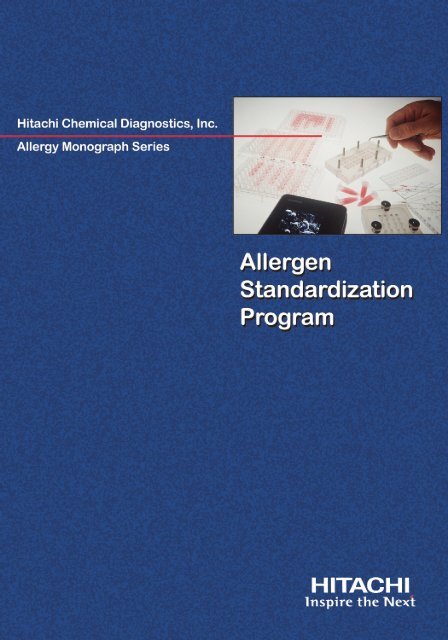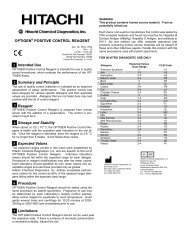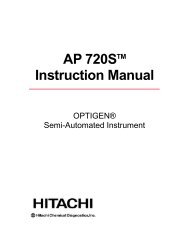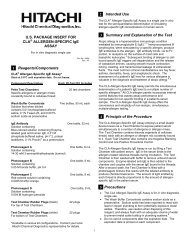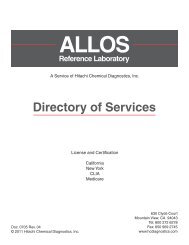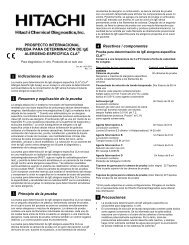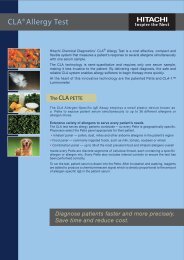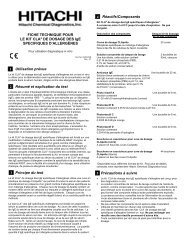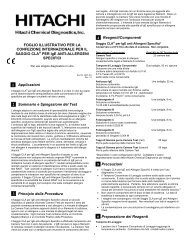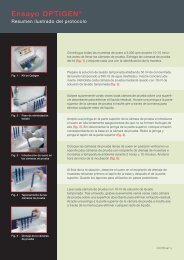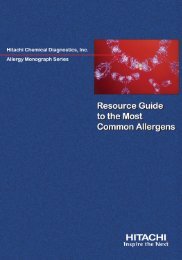Allergen Standardization Program - Hitachi Chemical Diagnostics
Allergen Standardization Program - Hitachi Chemical Diagnostics
Allergen Standardization Program - Hitachi Chemical Diagnostics
Create successful ePaper yourself
Turn your PDF publications into a flip-book with our unique Google optimized e-Paper software.
Introduction<br />
When in vitro diagnosis of allergy was introduced in the 1970s, the need for<br />
greater knowledge about the materials and chemistry affecting the reading and<br />
measurement of specific IgE antibodies became obvious. However, not until<br />
the 1990s did the research and knowledge on a significant number of common<br />
allergens and extract compositions become available. Now, a number of highly<br />
sophisticated technologies and the delineation of the molecular characterization<br />
of allergens allow the manufacturers of in vitro diagnostics to implement these<br />
advances in their product lines. It is now possible to provide reproducible lots<br />
of the most common allergenic extracts that retain all potential antigens, and<br />
exclude irrelevant materials under conditions which preserve the biological<br />
activity. The new knowledge and methods are all combined in the quality system<br />
developed by <strong>Hitachi</strong> <strong>Chemical</strong> <strong>Diagnostics</strong>, Inc. New lots of the allergen-containing<br />
reagent are standardized according to strict in-house quality control systems<br />
giving the clinical laboratory and referring physician the best opportunity to<br />
obtain reliable and reproducible test results to the benefit of the allergic patient.<br />
CLA ® Specific IgE Assay<br />
CLA is a diagnostic test for the simultaneous detection of specific IgE antibodies<br />
to different allergens. It uses a panel format as opposed to single allergen<br />
detection. The test chamber (Pette) contains up to 36 individual allergens<br />
coupled to a cotton thread solid phase. The test is performed by drawing the<br />
patient sera into the chamber for incubation followed by a buffer wash. A secondary<br />
antibody, anti-human IgE-HRP, is incubated in the chamber followed by a second<br />
buffer wash. The substrate is a chemiluminescent reagent. The luminescent<br />
signal is read in <strong>Hitachi</strong> <strong>Chemical</strong> <strong>Diagnostics</strong>’ CLA-1 Luminometer to determine<br />
the concentration of IgE specific antibody attached to the solid phase.<br />
CLA ® <strong>Allergen</strong> Specific Reagents<br />
The importance of the antibody and conjugate...<br />
The analytical performance profile of an immunoassay system is highly dependent<br />
on the affinity and specificity of the secondary antibody as well as the optimal<br />
conditions of the conjugation procedure. The CLA test uses a polyclonal anti-IgE<br />
antibody conjugated to Horseradish peroxidase (anti IgE-HRP). The conjugation<br />
has been optimized according to: oxidant concentration, HRP concentration,<br />
HRP antibody ratio, coupling time, reductant used, and time of addition. The<br />
quality of the conjugate formation is monitored by HPLC, which allows the<br />
operator to consistently stop the reaction to achieve conjugates with molecular<br />
weights of 200 to 400 kDa.<br />
1
The resulting in-house conjugate has a high signal with very low background.<br />
Graph 1 (below) shows the importance of monitoring and controlling the process<br />
in-house versus using a commercial vendor of the conjugate. The graphs<br />
depict a conjugate run with a negative serum sample to demonstrate the<br />
background (non-specific binding). It is clearly observed that the commercial<br />
vendor conjugate increases the non-specific binding which may result in false<br />
positive test results in the low-end. Graph 2 (below) shows the results of two<br />
conjugates run with a positive sample.<br />
Graph 1<br />
Graph 2<br />
A significantly lower background and higher signal were seen with the<br />
in-house conjugate.<br />
2
The importance of the allergen-containing reagent<br />
The allergen is a critical component in any allergy test. It is one of the major<br />
sources of discrepancy in the results seen between different in vitro diagnostic<br />
tests and skin testing and is also one of the main sources of reproducibility<br />
problems between lots. The causes of variation include the raw material source,<br />
extraction procedure and the coupling procedure.<br />
Thus, characterization and standardization of the allergen-containing reagents<br />
require the use of the best raw materials containing all-important allergenic<br />
proteins. Well-characterized extracts will improve lot to lot reproducibility and<br />
provide a standard of reference for manufacturing. Clinical and analytical<br />
performance of the assay can be compared with the available documentation<br />
on the molecular composition of allergenic extracts. This in turn will allow a<br />
comprehensive evaluation of the overall diagnostic performance of the CLA<br />
test in the clinical laboratory. The following outlines the allergen quality program<br />
used by <strong>Hitachi</strong> <strong>Chemical</strong> <strong>Diagnostics</strong>.<br />
Literature search: Before initiation of the standardization work, a search is<br />
done for each allergen to identify major and minor allergens, extraction procedures,<br />
and epidemiological studies.<br />
Raw materials: The raw material selected<br />
for each allergen determines the quality of<br />
the finished product. Given the variability in<br />
raw materials available from vendors, an in<br />
depth investigation is performed for each<br />
allergen. Raw materials are purchased from<br />
different vendors. Different species, collection<br />
sites, and collection years are tested when<br />
available. Various preparation methods of the<br />
crude extract are tested. The raw materials<br />
are extracted and analyzed by SDS-PAGE<br />
to determine the presence of major and minor<br />
allergens. Often a significant difference is<br />
observed between raw materials purchased<br />
Figure 1<br />
from different vendors. The SDS-PAGE above (Figure 1) shows an example of<br />
the difference found in raw materials from different vendors for Kentucky Blue<br />
Grass. The vendors tested were Crystal Labs, New England Antigenics, Biopol<br />
and a Standardized extract from Bayer.<br />
The major allergens for Kentucky Blue Grass are Poa p 1a (35.8 K), Poa p<br />
1b (33K), Poa p IX (55, 36, 34, 32, 28-29, 12K). The SDS-PAGE showed<br />
the absence of most major protein bands in two of the raw materials tested.<br />
3
Another example is shown in the SDS-PAGE picture<br />
to the left (Figure 2). A significant difference in<br />
protein pattern may also be noted between different<br />
species of the same allergens. This picture<br />
demonstrates the difference between two different<br />
species of Tuna: Yellow Fin and Albacore.<br />
Based on these raw material studies, the source<br />
material representing the best epitope variety of the<br />
allergen is selected for further characterization.<br />
Optimal pH and buffer for extraction: Once a raw<br />
material is selected, the optimal extraction method is<br />
investigated. Several buffers, pHs, and additives<br />
such as EDTA are tested. Sometimes a large difference<br />
Figure 2 in signal may be observed when different extraction<br />
methods are used. The graph below (Graph 3) shows an example of the<br />
response of Short Ragweed extracted with Phosphate Buffer with and without<br />
EDTA tested with different serum samples.<br />
Graph 3<br />
The method of choice for this allergen was Phosphate Buffer with EDTA. Other<br />
extraction conditions tested rendered lower results.<br />
4
Extraction procedures: Several extraction procedures are investigated for<br />
each allergen. Some of the procedures tested are: hot extraction, overnight<br />
extraction, bead beater treatments, ammonium sulfate precipitation and<br />
protein purification. The graph below (Graph 4) shows an example of the<br />
difference in low-end sensitivity detection for Mountain Cedar extracted by<br />
two different methods.<br />
Graph 4<br />
A significant increase in low-end sensitivity<br />
was seen with the ammonium sulfate<br />
precipitation method as compared to the<br />
overnight extraction.<br />
The SDS-PAGE to the right (Figure 3)<br />
illustrates the difference in the protein<br />
profile of tuna extracted with the following<br />
methods: raw, cooked and canned material.<br />
The response of patient sera to the three<br />
different extraction methods was different.<br />
Some patient sera reacted to the raw<br />
extract but not to the cooked and canned,<br />
whereas some patient sera reacted to the<br />
cooked and not the raw material. These<br />
results indicate the importance of choosing<br />
the right extraction procedure for in vitro<br />
as well as in vivo allergy testing.<br />
5<br />
Figure 3
Optimization of coupling procedure: Once the raw material and the extraction<br />
procedure is selected, the coupling conditions are optimized. Different buffers,<br />
pHs, and concentrations are tested to couple the allergen to the cotton thread<br />
solid phase. Sometimes differences in signal are seen with the coupling methods<br />
used that are specific to the allergen and to the sera tested. The graph below<br />
(Graph 5) illustrates the difference in response seen for a patient allergic to<br />
Japanese Cedar, coupled at different pHs.<br />
Graph 5<br />
For the patient tested, the best coupling pH was 7.2. However, other patients<br />
reacted better to Japanese Cedar coupled at 8.5. The optimal procedure is<br />
selected based on a large number of serum samples tested.<br />
6
Dilution curves of positive sera: When the allergen is optimized, a dilution<br />
curve of high positive responding sera is tested to determine linearity and<br />
low-end sensitivity. The graph below (Graph 6) shows an example of a dilution<br />
curve for Cockroach (German, American and a mix of both).<br />
Graph 6<br />
7
Extract characterization: Characterization of each one of the allergens is a<br />
major part of this quality control system. For each extract the following analyses<br />
are done: protein determination, SDS-PAGE, western blot analysis with several<br />
positive and negative samples, and capillary electrophoresis. An example of<br />
this analysis for English Plantain is shown below (Figure 4).<br />
Figure 4<br />
The SDS-PAGE shows the protein pattern for the allergen as well as the major<br />
proteins. It is the first step to ensure the presence of the proteins needed.<br />
The capillary electrophoresis is a blue print of the allergen composition that is<br />
easy and fast to perform. The western blots with different positive sera show<br />
the immunological activity of the proteins. The western blots are also used to<br />
document the presence of major and minor allergens. A representative group<br />
of positive sera that reacts to different proteins are selected for each allergen.<br />
8
Extract and pette stability: Stability at the extract and pette level is<br />
determined for each allergen once the extraction and coupling procedures<br />
are optimized.<br />
In-house clinical studies: Performance studies are undertaken for each<br />
standardized allergen using sera from allergic patients. The CLA test response<br />
is compared to Pharmacia ® CAP. The sensitivity, specificity and efficiency with a<br />
reference to CAP are calculated. The results of such a study with Burning Bush<br />
are shown below (Table 1).<br />
Table 1<br />
Documentation and validation: Per ISO 9001 and FDA regulations, a validation<br />
is done for each allergen. All the documentation needed for manufacturing and<br />
quality assurance is completed before the transfer to Manufacturing.<br />
9
Sera library for quality assurance: Positive sera reactive to different protein<br />
bands are selected for each allergen. The serum is selected by performing<br />
western blot analysis so the protein response for each serum is known. The<br />
sera is purchased in large volumes and transferred to the Quality Assurance<br />
department. The table below (Table 2) is an example of the sera selected for<br />
Egg White.<br />
Table 2<br />
Each sera has a Pharmacia CAP and a CLA Class value, as well as the<br />
response of the sera to the different allergenic proteins in Egg White. This<br />
detailed information on each of the quality assurance samples allows<br />
the manufacturing group to spot allergens deficient in important proteins.<br />
Standardized allergen blueprint: To ascertain consistency and reproducibility<br />
between lots, subsequent lots are compared to the blueprint of the established<br />
in-house allergen reference standard. A file with detailed information on the<br />
extraction, coupling, extract characterization and qualification procedure for<br />
each allergen is completed for each allergen reference standard and is available<br />
for the Manufacturing group as a quick and easy reference for manufacturing<br />
standardized allergens. Upon completion of the standardization of each<br />
allergen, a multifunctional team assures transfer and implementation to<br />
Manufacturing and Quality Assurance.<br />
To date more than 50 of the most common allergens have gone through<br />
the standardization procedure (a list is available upon request).<br />
Summary: The <strong>Allergen</strong> <strong>Standardization</strong> <strong>Program</strong> has aided HCD in the<br />
development of a scientifically well-characterized product. It has also aided<br />
in the understanding of allergens that have not been studied in detail and for<br />
which information on allergenic proteins was not previously available. The<br />
program incorporates and conforms to the guidelines published by the<br />
NACCLS. The new in-house conjugate in combination with the <strong>Allergen</strong><br />
<strong>Standardization</strong> <strong>Program</strong> has enhanced the quality of the CLA Allergy Test as<br />
well as the reproducibility between reagent and allergen lots.<br />
10
European Office<br />
<strong>Hitachi</strong> <strong>Chemical</strong> <strong>Diagnostics</strong>, Inc.<br />
<strong>Hitachi</strong> Europe Ltd.<br />
Whitebrook Park<br />
Lower Cookham Road<br />
Maidenhead, Berkshire SL6 8YA<br />
United Kingdom<br />
44 (0) 1628 585 590<br />
United States Office<br />
<strong>Hitachi</strong> <strong>Chemical</strong> <strong>Diagnostics</strong>, Inc.<br />
630 Clyde Court<br />
Mountain View, CA 94043-2239<br />
650 961 5501<br />
800 233 6278<br />
www.hcdiagnostics.com<br />
© 1998 - 2003 <strong>Hitachi</strong> <strong>Chemical</strong> <strong>Diagnostics</strong>, Inc.<br />
Doc. No. 0576 Rev. 03


